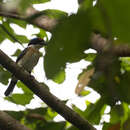Biology
(
englanti
)
tarjonnut Arkive
Frequently seen perching high up in trees, the rufous-lored kingfisher will often swoop down to the ground to feed (4). It consumes a variety of insects, including grasshoppers, cicadas, beetles, larvae, and also spiders (2), capturing the prey in its straight, dagger-shaped bill (5), and battering any large items before swallowing (2)
Little information is available on the breeding biology of the rufous-lored kingfisher, other than records of males with moderately large testes in April and May, and a female with ripe eggs in April. Juveniles have been seen between April and August, depending on the island (4).
Conservation
(
englanti
)
tarjonnut Arkive
The rufous-lored kingfisher has been recorded from a number of protected areas, but these offer variable, and not always sufficient, protection. For example, in Rajah Sikatuna National Park on Bohol, a key site for this kingfisher, illegal logging poses a major threat (2). While specific actions have been recommended for the rufous-lored kingfisher, such as conducting surveys and research to clarify its current distribution, status and ecological preferences (3), this species' long-term survival is intrinsically linked to the survival of the remaining forests, an aim which will require much greater measures. Hopefully, action will be taken in time to stave off the extinction crisis that some have predicted for the Philippines (7).
Description
(
englanti
)
tarjonnut Arkive
With its dazzling plumage, the rufous-lored kingfisher is a striking member of the kingfisher family. It has large rusty-orange spots in front of each eye, which give this species its common name, and a rusty-orange 'collar' around the back of the neck. The plumage is blackish with an iridescent blue gloss, which shines particularly bright on the top of the head and rump. Male rufous-lored kingfishers have white underparts, while those of the female are washed with a buffy-orange (2) (3). The plumage of juveniles is generally duller than that of adults and black barring covers the orange collar and breast (2). Five subspecies of the rufous-lored kingfisher are recognised, each differing slightly in the intensity of the blue upperparts and the colour of the female's underparts (2) (3). The rufous-lored kingfisher calls with a rapid series of short, clear whistles that decelerate as they descend in pitch (3)
Habitat
(
englanti
)
tarjonnut Arkive
This species inhabits small islands and coastal lowlands, where it apparently shows a preference for forest near boulders and cliffs, and for a presence of large trees (4). Whilst the rufous-lored kingfisher displays a preference for lowland habitat, on some islands it has been recorded at 1,000 metres above sea level (4).
Range
(
englanti
)
tarjonnut Arkive
The rufous-lored kingfisher is endemic to the Philippines, where the five subspecies are separated by their distribution. Todiramphus winchelli nesydrionetes occurs on the islands of Tablas, Romblon, Sibuyan and probably also Masbate and Sicogon, T. w. nigrorum inhabits Samar, Biliran, Leyte, Calico-an, Bohol, Cebu, Negros and Siquijor, T. w. mindanensis occurs on Mindanao, T. w. winchelli is found on Basilan and T. w. alfredi inhabits the Sulu archipelago (2) (4).
Status
(
englanti
)
tarjonnut Arkive
Classified as Vulnerable (VU) on the IUCN Red List 2007 (1).
Threats
(
englanti
)
tarjonnut Arkive
Described as the greatest and most rapid case of deforestation in the world (6), the destruction of the Philippines' forests poses a great threat to the survival of the rufous-lored kingfisher and the islands' many other inhabitants. The causes behind this devastating situation include commercial and illegal logging, clearance for oil palm, planting with exotic trees for paper production and the deliberate conflagration of forests (2) (4), compounded by a rapidly expanding human population (7). While logging has decreased considerably since the 1980s (primarily because there is little left to take), mining now poses an imminent threat to the remaining natural habitat (7).

